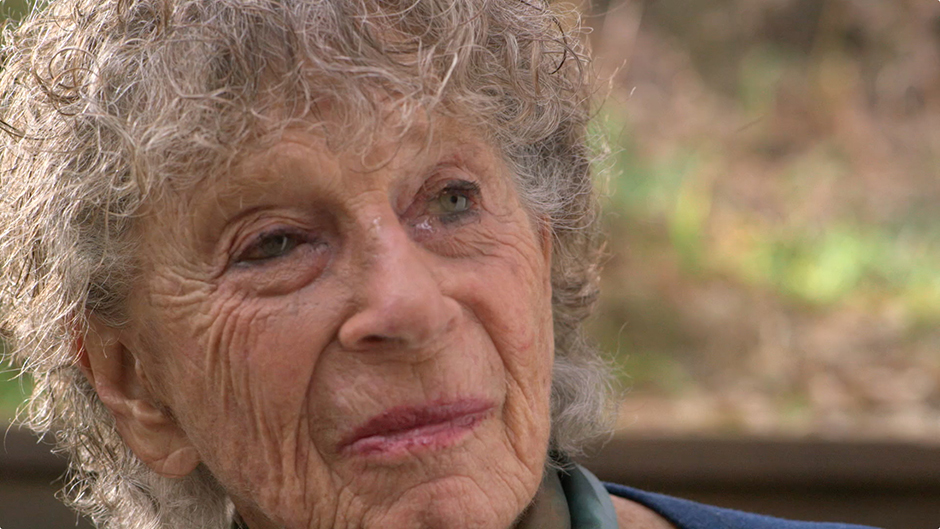
Janine Antoni, Anna Halprin, Stephen Petronio, Rope Dance, 2015. Courtesy of the artists and The Fabric Workshop and Museum, Philadelphia.
The Fabric Workshop and Museum offers residencies to artists, giving them the platform and the space to explore and expand upon pre-existing projects or those that are brand new. Currently on view until July 31st, 2016 is Ally a body of work by Janine Antoni and Stephen Petronio in collaboration with Anna Halprin. Spanning the multiple floors of the venue, Antoni and Petronio have made installations that function on their own and also within the realm of the performative gesture. That said, the remnants of these performances exist for visitors to peruse, even after the physical bodies are no longer present. Performances featuring both artists will occur throughout the duration of the exhibition and it is suggested to check the website’s calendar for specific dates and times.
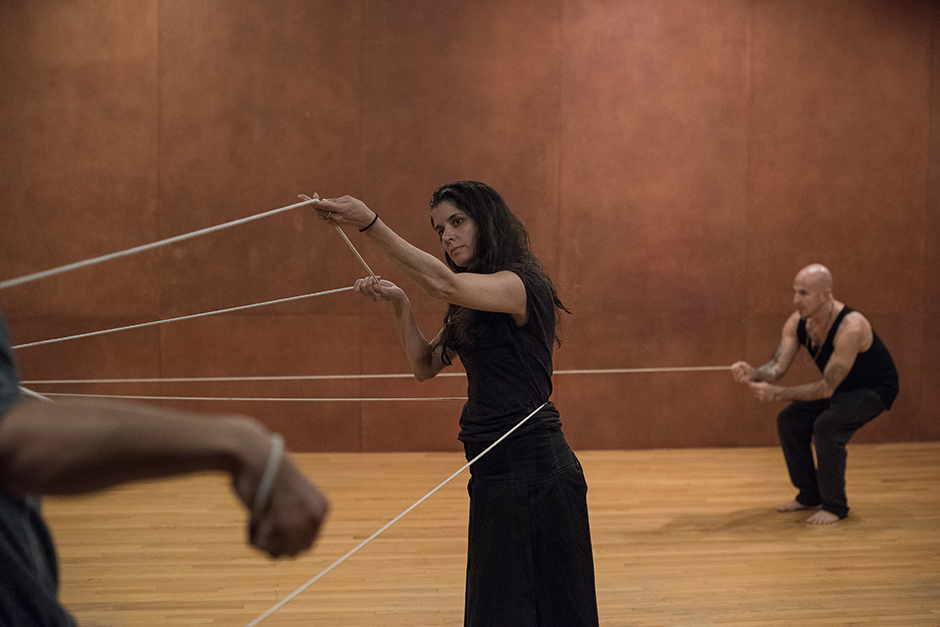
Janine Antoni, Anna Halprin, Stephen Petronio, Rope Dance, 2015. Photograph and © Hugo Glendinning. Courtesy of the artists and The Fabric Workshop and Museum, Philadelphia.
On the ground floor, a video, silent if not for headphones revealing minimal sound, is projected in an expansive room. A woman’s face, on in years, fills the rectangular screen. Her expression and gaze is locked on something we, the audience, cannot see. She grins as tears gather in the corners of her deeply creased eyes, before spilling over taught cheeks. A specific, yet unidentified source of joy and warmth is projected from this person, who is in observation of something that is obviously emotionally jarring but what we can only imagine. Is she in the past? Is her experience within a specific real space or mental space? We are reminded of the power of memory, and what it means to capture something within a technological medium, void of context. Tears of joy can emerge from so many sources. Is she looking at her grandchildren, thinking about a former lover, the birth of her child? In actuality, the figure who is larger than life on the screen is performance artist Anna Halprin and she was watching an iteration of one of her own performances by Stephen Petronio. At 95 years old, the nonagenarian choreographer is being celebrated across the globe with restaging of her performances in France and Israel along with film screenings in Colombia and South Korea. Beyond that of Martha Graham, hers is the formation of what we now know to be postmodern dance. Honoring her and this tradition of movement and belief that even a non-dancer can be a dancer, Petronio and Antoni have staged “Rope Dance” (2015) which utilizes those present visiting and observing the exhibition, requiring active participation. Guests are informed to remove their shoes and then chosen at random to stand, take hold of a rope and proceed to move in a variety of directions based on both commands and free will. Petronio dictates movement while Antoni also participates in the twisting and playful happenstance arrangements of bodies and twine. Having participated myself, the actions and movement required, both simplistic yet engaging, brought nothing if not smiles between strangers and a loosening of any tension which may have hung, invisible, in the air.
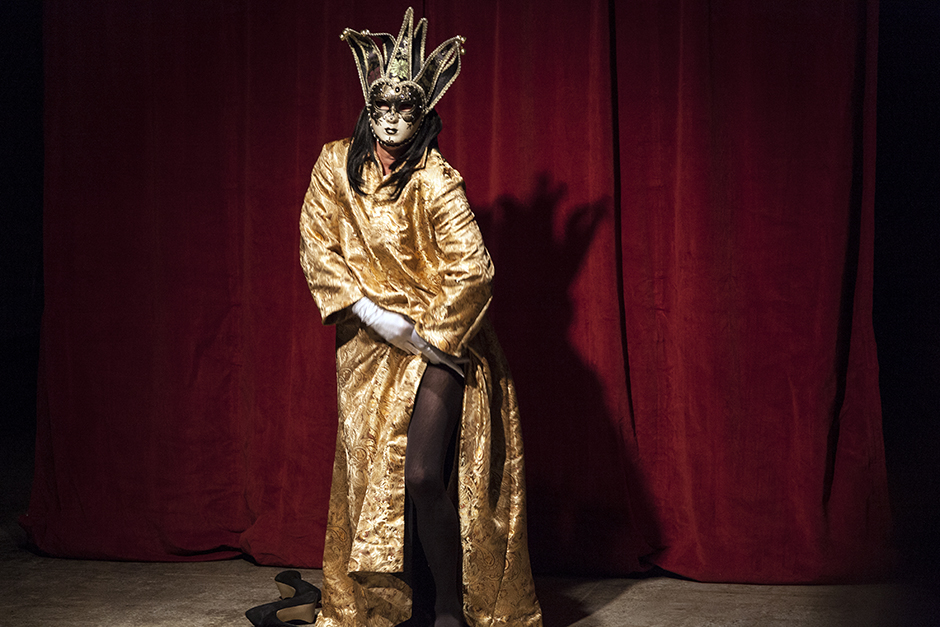
Stephen Petronio rendition of The Courtesan and the Crone by Anna Halprin, 2016. Exhibition detail from Ally, produced in collaboration with The Fabric Workshop and Museum. Photographed by Carlos Avendaño. Courtesy of the artists and The Fabric Workshop and Museum, Philadelphia.
Additional floors house a range of installations by the collaborative duo while they each have respective floors as well. Stephen Petronio performed “The Courtesan and the Crone” by Anna Halprin (2016) on the seventh floor, perhaps the least engaging of these renditions. Taking its cue from Venice Carnival, an elaborately robed figure emerges from behind a free-standing stage curtain, in one of the traditional masks associated with the Italian festivities. Moving seductively and slowly, flashing a hosiery draped leg and then giving those present a quick glimpse of male genitals tucked in the stockings, the figure is revealed to be Petronio. The mask and full length robe, easily hides the gender and other identifiable allusion to the body underneath, high heels and black nylons hinting at the what one would assume to be female. However, this act of playful jest is one that is no longer relevant. The shock of a non-conforming body is less interesting than it might have been in the past. In reading a description of the original conception of the performance by Halprin, she herself is the shrouded figure, one that conceals not only gender identity but also the effects of time on the body. In 2016, a sexiness and impish attempt at exclusion and inclusion within the relationship between performer and audience, is more difficult to achieve. One can only assume that the performance would have been more effective if it had been by Halprin and a reference to time, mortality and sexuality rather than gender play which is out of fashion and in actuality, boring.
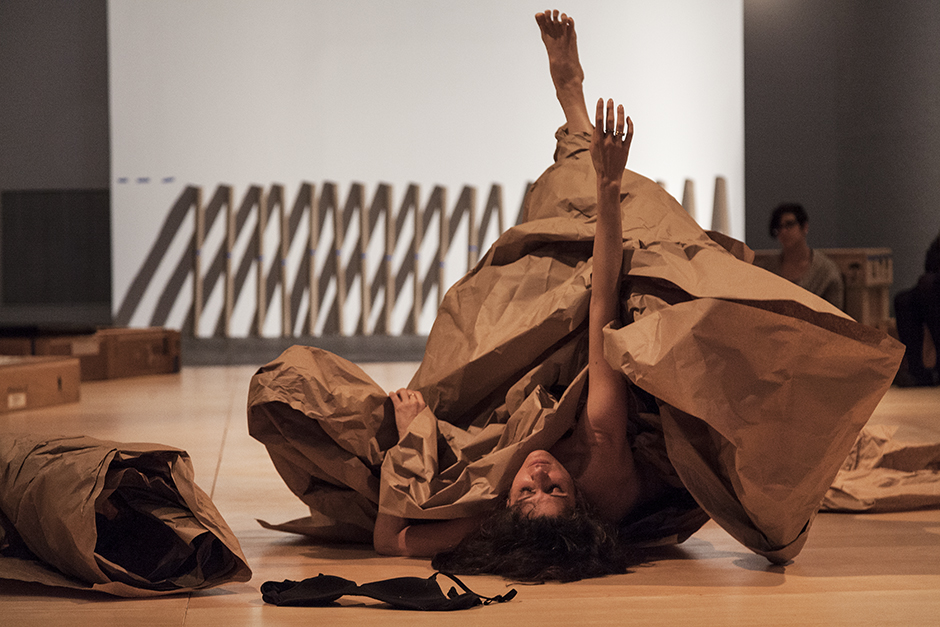
Janine Antoni in collaboration with Anna Halprin, Paper Dance, 2013. April 20, 2016 performance view from Ally, produced in collaboration with The Fabric Workshop and Museum. Photographed by Carlos Avendaño. Courtesy of the artists and The Fabric Workshop and Museum, Philadelphia.
In contrast, Janine Antoni performed “Paper Dance” (2013/2016) on the uppermost floor of The Fabric Workshop and Museum. In the room, pale wooden boxes lined both sides of the wall. Visitors are invited to sit and are given blankets for extra cushion. Upon observation, it is revealed that the boxes actually house sculptural and photographic works of Antoni’s boxed as they had been shipped and now serving to seat those present. At the initiation of “Paper Dance” Antoni unwraps one of these works, chosen assumingly, at random. Once the piece is on view, she commences the interaction with, as the title divulges, paper. Wrapping, rolling in and out of an extended length of brown paper, the body and the paper unlikely dance partners, merge. At once clothed, Antoni undresses from, shedding the fabric encasing her form in favor of paper. It could be said that the performance functions both as a sculpture and a live drawing. The artist moves through the gallery, snaking along the ground, dragging the paper, circling inside it, tearing it and crumpling. The paper is both a ground and another body, a partner. Projected on the wall of the gallery, on view for the duration of the performance, is the black and white film version of the original performance of “Paper Dance” from Anna Halprin’s Parades and Changes, circa 1964-1965. While the present is at times, seemingly, more relevant than the past, it is in this space that we are forced to be made aware of the timeline and duration of these interactions and how there is a freedom in artistic license. There is an ongoing battle between our fleshy, mortal bodies and the world we exist in. The physicality of “Paper Dance” is just that, a visual solution to how we exist in space, exploring the nature of movement, time and the weight of the body as it interacts with a plausible, if malleable, construction of our own making.
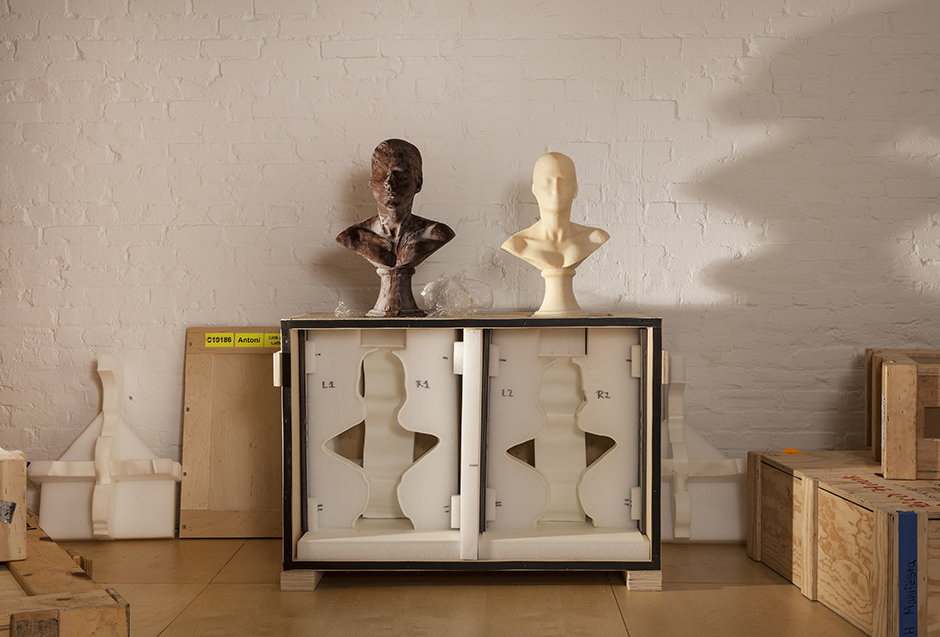
Janine Antoni in collaboration with Anna Halprin, Paper Dance, 2013. April 21, 2016 performance view from Ally, produced in collaboration with The Fabric Workshop and Museum. Photographed by Carlos Avendaño. Courtesy of the artists and The Fabric Workshop and Museum, Philadelphia.
Ally, is on view at The Fabric Workshop and Museum in Philadelphia until July 31st, 2016. Please be sure to check their website for up to date notification on live performances. Also, the museum is having an Open Call titled How We Move: A Collaborative Video Project has an open submission until Monday, June 6, 2016.
Performance and Reception: June 10, 2016–from 4:00 to 6:00 pm , Free to High School Students
Katy Diamond Hamer is the founding editor of Eyes Towards the Dove. Be sure to follow her on Instagram, @katyhamer
